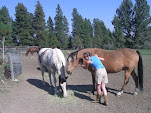
We just watched our last neighbor cut, fluff, bale and stack the 2nd cutting of hay. This means something.
The irrigation companies turn on the water in late April. The ranches along the route wait as the water makes it way from the reservoirs down the irrigation ditches, filling irrigation ponds. When your neighbor up the ditch starts watering, you know your turn is next.
In preparation for the incoming supply of water, fields are often burned, turned, seeded, pipes are put out, equipment is emptied of the mice nests that built up over the winter, whatever is necessary to prepare.
Then for the next 2 - 2 1/2 months we monitor and adjust water flow, change the location of irrigation heads to be sure every blade is getting showered, we wait and watch as the hay grows under the sun of the long days here in Central Oregon. It grows by inches in a day. Each ranch shuts off the water when they are preparing to cut; this gives the hay time to dry. Then the first cutting comes, some time in late June/early July. The 1st cutting is a herald of summer--it's officially here. This is exciting! It's summer, it's hot, and everything is alive!
Once the hay is cut, baled and stacked, the watering begins again to grow the 2nd cutting. But then when the 2nd cutting comes, during the weeks of September, it means something else. The days are shorter, the hay of the 2nd cutting isn't as power-packed as the 1st, it doesn't grow as energetically as the 1st. And we all know it means fall is coming. There isn't a 3rd cutting.
The watering begins again, but this time just to keep the grass growing and green and give the horses pasture to eat before it goes dormant in the winter. The irrigation will be shut down at the beginning of October. No more "tick tick tick tick tick" of the water guns as they rotate around in a circle showering feet of green carpet. That is a summer sound.
Who would have thought that there was so much significance in cutting hay? It marks a definite season, for sure.

No comments:
Post a Comment